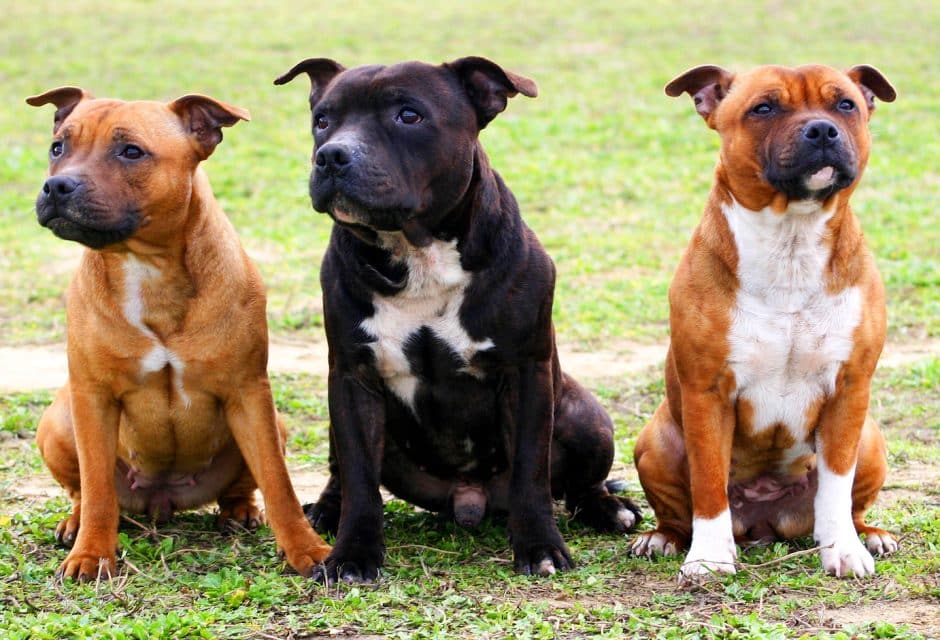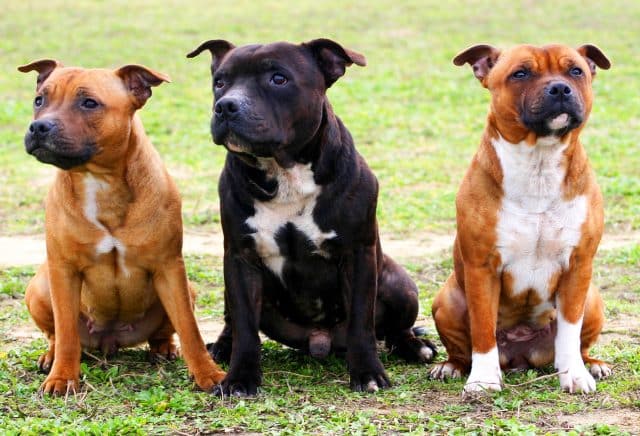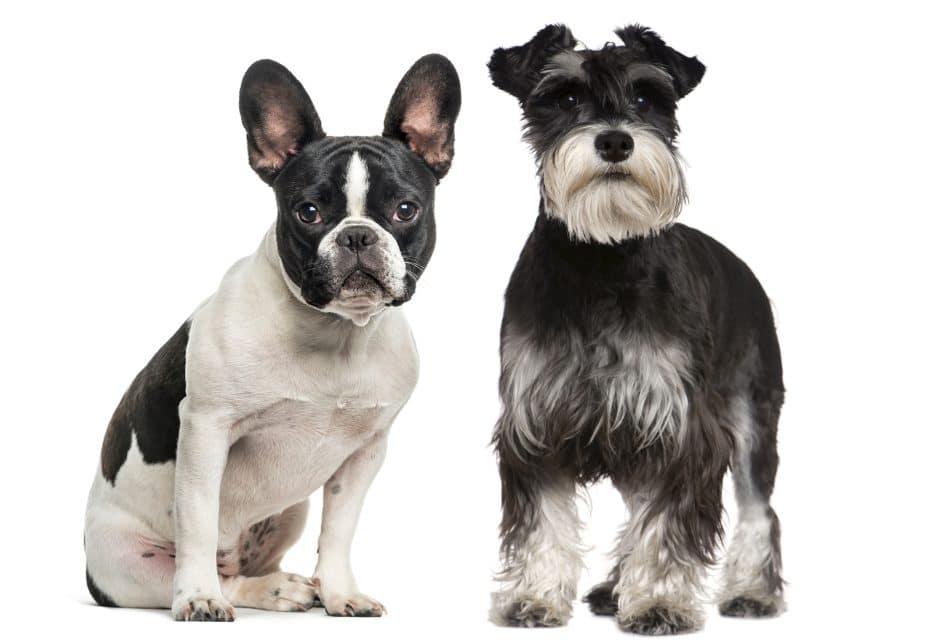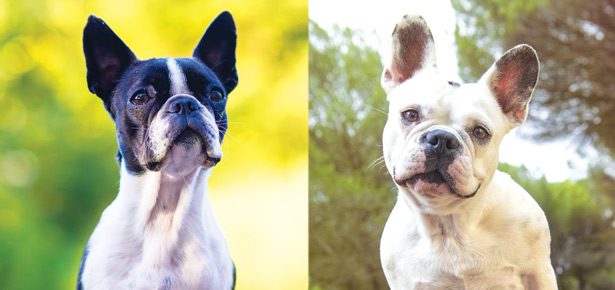

The Staffordshire Bull Terrier
The Right Staff
“Houston, we have a problem.” “A wide-spread malfunction in the communications system is causing crew members to be mistaken for hostiles. Please advise.”
Pit Bull. Devil dog. Killer. The Staffordshire Bull Terrier (also called the Staffie, Stafford or SBT) is none of these, yet he is constantly mislabelled. Frequently just lumped in with other “bully” breeds and slapped with breed- specific legislation that can condemn dogs to a lifetime of muzzles and close confinement or even send them to death, the Stafford does, indeed, have a serious problem. Yet, those who know the breed well say it is rarely aggressive towards humans. In the United Kingdom, the Stafford is sometimes called “the nanny dog” for his solid reputation as a family dog, and under the official breed standards of several countries, including the United States, Canada, and the United Kingdom, the Stafford must be affectionate with children. Few standards go that far in mandating a breed’s compatibility with children.

Life on White/Bigstock
Confusion in the public’s mind among several breeds, including the Staffordshire Bull Terrier, Bull Terrier, Bulldog, American Staffordshire Terrier, and Pit Bull, along with mixed-breeds arising from or even merely resembling those breeds, is one major issue. A child is bitten, the news reports another vicious attack by a “Pit Bull,” and since most people cannot tell the difference between these breeds, everyone glances fearfully at the neighbour’s jovial Bull Terrier or the well-behaved Stafford down the street.
The Staffordshire Bull Terrier’s appearance—compact, solidly muscled, broad chest, wide mouth—probably also contributes to its unearned reputation. This is a dog that looks like a bare-knuckles boxer in peak condition. Dayna Lemke, author of A New Owner’s Guide to Staffordshire Bull Terriers, writes: “Part of their charm is that they look so tough, but they really aren’t. Their inner beauty will steal your heart.”
Like most breeds, the Staffordshire Bull Terrier is a product of its heritage and breeding—for both good and ill. There is no getting around the fact that the Stafford was originally created in late 18th- and early 19th-century northern England for the “sport” of dogfighting, so it is not a breed that always socializes easily with other dogs or animals. Lemke says: “Staffords can be dog aggressive. It’s better to go into the Stafford experience expecting to have a dog who isn’t canine social than the other way around.” Early and extensive socialization with other dogs and animals is recommended for all Staffords.
Most Popular Dogs in the US
According to the most recent AKC registration statistics (2022)
[1] French Bulldog
[2] Labrador Retriever
[3] Golden Retriever
[4] German Shepherd
[5] Poodle
[6] Bulldog
[7] Rottweiler
[8] Beagle
[9] Dachshund
[10] German Shorthaired Pointer
[75] Staffordshire Bull Terrier
At the same time, those who bred dogs for fighting were usually working-class men who kept their dogs in the home with their families and were likely ruthless in weeding out any animals that showed aggression towards humans. Thus, the SBT Club of Canada writes: “The Staffordshire Bull Terrier is one of the friendliest and silliest breeds in the dog world. They are highly intelligent and extremely submissive to people.”
Individual dogs, whether Stafforshire Bull Terriers or members of other bully breeds—indeed, individual dogs of any breed—are also, ultimately, products of their own unique situation. Their birth, upbringing, and training play a crucial role in determining their behaviour. An experienced, firm, and consistent handler will produce the dog desired. The American Kennel Club website states: “While the Staffordshire Bull Terrier is a sweet-tempered, affectionate dog, his strength and determination require an experienced owner who can work with him in a firm, but gentle way.”

hugofelix/Bigstock
Famed conservationist, animal handler, and TV personality Steve Irwin raised his Staffordshire Bull Terrier, Sui, from a pup and rarely went on an adventure without her by his side. He trained Sui to help him wrangle crocodiles, wild pigs, and snakes and she was seen in many episodes of Irwin’s show The Crocodile Hunter.
She was, according to the page dedicated to her on his website, his: “loyal friend, protector and wildlife warrior.” Irwin loved Sui enough to name his daughter, Bindi Sue, after her, and the Staffordshire Bull Terrier and the little girl shared a special bond. “Sui protected Bindi for six years,” wrote Irwin. “It was so funny—no-one was allowed to muck with Bindi whilst Sui was guarding her. Then Bindi would put bows in her hair and play Barbies with her, we lost count how many times Bindi fell asleep on top of a very, very patient Sui.”
After a long and exciting life, Sui passed away at the age of 16, not unusual for this breed, which is typically healthy, athletic, and long-lived. Staffordshire Bull Terrier breeders should test for hereditary cataracts and L2- HGA, L2-hydroxyglutaric aciduria, a rare disorder that affects the breed.
Sui was a typical Staffordshire Bull Terrier in another way: she spent her life as the beloved member of a human family, sharing their daily chores and their escapades. This is where a Staffordshire Bull Terrier excels. “Staffords are so people-oriented that they don’t need canine companionship if they are getting plenty of attention from their human family,” says Lemke.
The Staffordshire Bull Terrier is not a breed to suit every owner, but for those who appreciate this dog’s unique characteristics and are prepared for a bold, tenacious, and loyal companion that prefers human friendship over canine buddies, he does indeed have “the right stuff.”
» Read Your Breed For more breed profiles, go to moderndogmagazine.com/breeds
Join the newsletter and never miss out on dog content again!
"*" indicates required fields
By clicking the arrow, you agree to our web Terms of Use and Privacy & Cookie Policy. Easy unsubscribe links are provided in every email.






